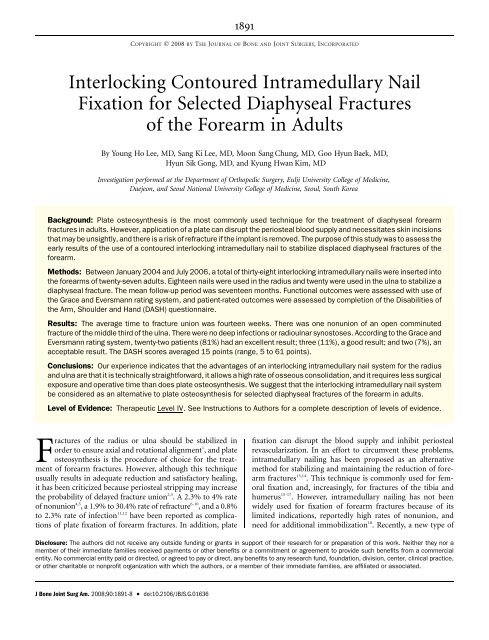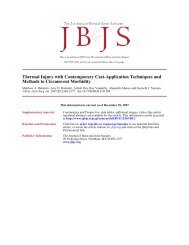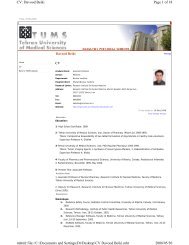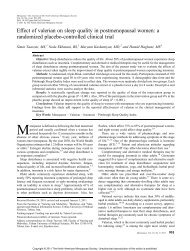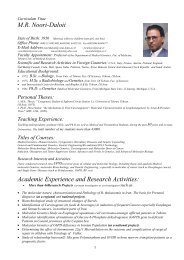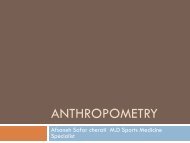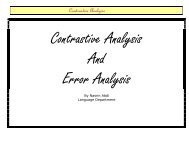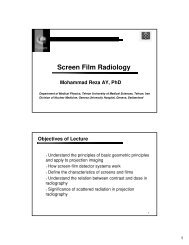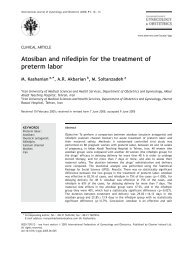Interlocking Contoured Intramedullary Nail Fixation for Selected ...
Interlocking Contoured Intramedullary Nail Fixation for Selected ...
Interlocking Contoured Intramedullary Nail Fixation for Selected ...
Create successful ePaper yourself
Turn your PDF publications into a flip-book with our unique Google optimized e-Paper software.
<strong>Interlocking</strong> <strong>Contoured</strong> <strong>Intramedullary</strong> <strong>Nail</strong><br />
<strong>Fixation</strong> <strong>for</strong> <strong>Selected</strong> Diaphyseal Fractures<br />
of the Forearm in Adults<br />
By Young Ho Lee, MD, Sang Ki Lee, MD, Moon Sang Chung, MD, Goo Hyun Baek, MD,<br />
Hyun Sik Gong, MD, and Kyung Hwan Kim, MD<br />
Investigation per<strong>for</strong>med at the Department of Orthopedic Surgery, Eulji University College of Medicine,<br />
Daejeon, and Seoul National University College of Medicine, Seoul, South Korea<br />
Background: Plate osteosynthesis is the most commonly used technique <strong>for</strong> the treatment of diaphyseal <strong>for</strong>earm<br />
fractures in adults. However, application of a plate can disrupt the periosteal blood supply and necessitates skin incisions<br />
that may be unsightly, and there is a risk of refracture if the implant is removed. The purpose of this study was to assess the<br />
early results of the use of a contoured interlocking intramedullary nail to stabilize displaced diaphyseal fractures of the<br />
<strong>for</strong>earm.<br />
Methods: Between January 2004 and July 2006, a total of thirty-eight interlocking intramedullary nails were inserted into<br />
the <strong>for</strong>earms of twenty-seven adults. Eighteen nails were used in the radius and twenty were used in the ulna to stabilize a<br />
diaphyseal fracture. The mean follow-up period was seventeen months. Functional outcomes were assessed with use of<br />
the Grace and Eversmann rating system, and patient-rated outcomes were assessed by completion of the Disabilities of<br />
the Arm, Shoulder and Hand (DASH) questionnaire.<br />
Results: The average time to fracture union was fourteen weeks. There was one nonunion of an open comminuted<br />
fracture of the middle third of the ulna. There were no deep infections or radioulnar synostoses. According to the Grace and<br />
Eversmann rating system, twenty-two patients (81%) had an excellent result; three (11%), a good result; and two (7%), an<br />
acceptable result. The DASH scores averaged 15 points (range, 5 to 61 points).<br />
Conclusions: Our experience indicates that the advantages of an interlocking intramedullary nail system <strong>for</strong> the radius<br />
and ulna are that it is technically straight<strong>for</strong>ward, it allows a high rate of osseous consolidation, and it requires less surgical<br />
exposure and operative time than does plate osteosynthesis. We suggest that the interlocking intramedullary nail system<br />
be considered as an alternative to plate osteosynthesis <strong>for</strong> selected diaphyseal fractures of the <strong>for</strong>earm in adults.<br />
Level of Evidence: Therapeutic Level IV. See Instructions to Authors <strong>for</strong> a complete description of levels of evidence.<br />
Fractures of the radius or ulna should be stabilized in<br />
order to ensure axial and rotational alignment 1 , and plate<br />
osteosynthesis is the procedure of choice <strong>for</strong> the treatment<br />
of <strong>for</strong>earm fractures. However, although this technique<br />
usually results in adequate reduction and satisfactory healing,<br />
it has been criticized because periosteal stripping may increase<br />
the probability of delayed fracture union 2,3 . A 2.3% to 4% rate<br />
of nonunion 4,5 , a 1.9% to 30.4% rate of refracture 6-10 ,anda0.8%<br />
to 2.3% rate of infection 11,12 have been reported as complications<br />
of plate fixation of <strong>for</strong>earm fractures. In addition, plate<br />
1891<br />
COPYRIGHT Ó 2008 BY THE JOURNAL OF BONE AND JOINT SURGERY, INCORPORATED<br />
fixation can disrupt the blood supply and inhibit periosteal<br />
revascularization. In an ef<strong>for</strong>t to circumvent these problems,<br />
intramedullary nailing has been proposed as an alternative<br />
method <strong>for</strong> stabilizing and maintaining the reduction of <strong>for</strong>earm<br />
fractures 13,14 . This technique is commonly used <strong>for</strong> femoral<br />
fixation and, increasingly, <strong>for</strong> fractures of the tibia and<br />
humerus 15-17 . However, intramedullary nailing has not been<br />
widely used <strong>for</strong> fixation of <strong>for</strong>earm fractures because of its<br />
limited indications, reportedly high rates of nonunion, and<br />
need <strong>for</strong> additional immobilization 18 . Recently, a new type of<br />
Disclosure: The authors did not receive any outside funding or grants in support of their research <strong>for</strong> or preparation of this work. Neither they nor a<br />
member of their immediate families received payments or other benefits or a commitment or agreement to provide such benefits from a commercial<br />
entity. No commercial entity paid or directed, or agreed to pay or direct, any benefits to any research fund, foundation, division, center, clinical practice,<br />
or other charitable or nonprofit organization with which the authors, or a member of their immediate families, are affiliated or associated.<br />
J Bone Joint Surg Am. 2008;90:1891-8 d doi:10.2106/JBJS.G.01636


